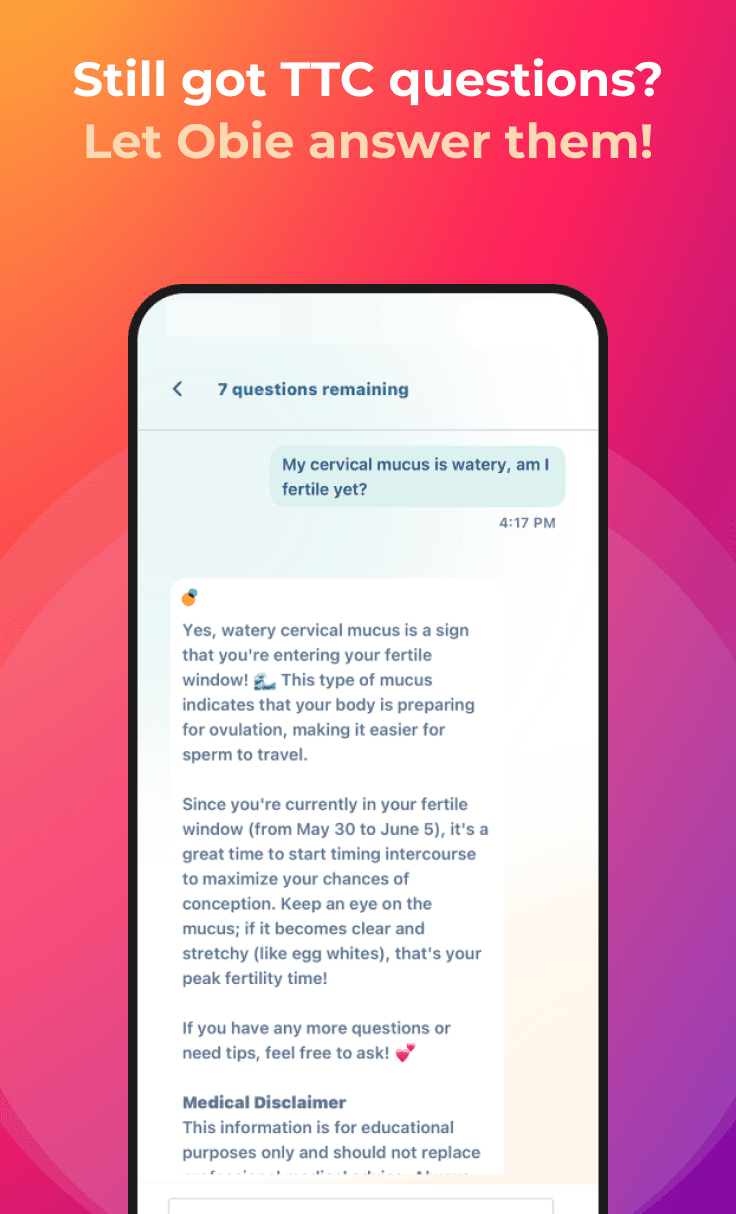Egg-White Cervical Mucus and Fertility
Fertility Awareness
Obie Editorial Team

How fertile are you? Take our online fertility test and get your personal report instantly!
Cervical mucus: a sperm's best friend
The cervix is at the end of the vagina, at the entrance to the uterus. Cervical mucus is produced by the cervical glands in the cervix. The physical properties of cervical mucus change during the menstrual cycle.
Cervical mucus is very important because it regulates fertility. It accepts, filters, prepares, and releases sperm for successful transport to the inside of the uterus, then on to the fallopian tubes to meet the egg to be fertilized and implanted. Cervical mucus is essential to your fertility: No cervical mucus, thick cervical mucus, "sperm unfriendly" cervical mucus, or too little cervical mucus means that no or very small numbers of sperm enter the uterus.
Your cervical mucus is the thinnest and best shortly before and during ovulation. This is the best time for sperm transport because the cervical mucus is thin and stretchy (known as egg white cervical mucus, or EWCM).
What is cervical mucus?
Cervical mucus (CM) is produced by glands in the cervix, the entrance to the uterus. It accepts, filters, prepares, and releases sperm for successful transport to the inside of the uterus, then, on to the fallopian tubes and the egg for fertilization.
The physical properties of the cervical mucus change during the menstrual cycle. The cervical mucus is produced by the cervix and changes consistency throughout your menstrual cycle based on hormones associated with fertility, egg development, and ovulation. Shortly after the menstrual period ends, the cervical mucus is dry and prevents sperm from penetrating the cervix but around the time of ovulation it becomes thin, has egg-white consistency, and is penetrable by sperm.
After ovulation, it becomes thick and won't allow any more sperm to enter the uterus.
Find out how to check your cervical mucus!
How long before I ovulate will my mucus become stretchy?
Spinnbarkeit (German for "stretchiness"), the ability of the mucus to stretch like egg white (EW or EWCM = Egg-White Cervical Mucus) usually starts several days before ovulation and ends within one to two days after ovulation (see graph here). However, many women report it happens longer, or shorter, before ovulation, and some women have no egg-white fluid at all despite regular ovulation.
Does having egg-white cervical mucus (EWCM) mean that I am fertile?
Egg white cervical mucus (EWCM) is a type of cervical fluid that is produced right before ovulation, during a time when you are most fertile. This mucus is called EWCM because it strongly resembles raw egg white in that it is clear or streaked, and is very stretchy and can also be watery. By placing your clean fingers into your vagina and obtaining a sample you can check for the appearance of EWCM. When a sample of mucus is between your fingers, it may stretch for several inches and should look somewhat like raw egg whites.
EWCM usually indicates fertility and that you are close to ovulation.
Women in their early twenties typically have more days of EWCM than women in their thirties. Although it is not always true, women in their twenties will have around 5 days of EWCM and women in their thirties may have only 1 or two days with EWCM. Being that this mucus is necessary for conception, you should try to increase the amount you have present. This can be done by preventing dehydration and using supplements like evening primrose oil. FertileCM is a safe, dietary supplement formulated specifically to help increase EWCM quantity and quality.
Cervical mucus throughout the menstrual cycle
| Day in cycle (approximate) | Consistency |
| Days 1-5 | Menses; menstrual period; bleeding |
| Days 6-9 | Dry; little or no cervical mucus |
| Days 10-12 | Sticky thick mucus, becoming less thick and whiter |
| Days 13-15 (most fertile time) | Egg-white or "spinnbarkeit" mucus: thin, elastic, slippery; stretchy, clear |
| Days 16-21 | Sticky thick cervical mucus |
| Days 22-28 | Dry cervical mucus |
Can I get pregnant even with little to no cervical mucus?
Yes, you can get pregnant with little or no cervical mucus. As long as you ovulate you can get pregnant, even without the typical mucus. Not having the typical stretchy mucus may make becoming pregnant somewhat more difficult, so you may want to ask your doctor about it, and get examined to confirm your finding.
What happens to cervical mucus during pregnancy?
Making the diagnosis of pregnancy solely from changes in the cervical mucus is too unreliable. You cannot make a pregnancy diagnosis from cervical changes alone. The typical stretchy and fertile cervical mucus develops under the influence of estrogen hormones. Estrogen hormones rise just before ovulation and decrease just after ovulation. At that time, cervical mucus becomes dry. About 7-10 days after ovulation, estrogen hormones normally rise again, and it is this second rise than can often give the appearance of fertile mucus again. That doesn't mean you are fertile again because you don't ovulate again. There are no reliable enough changes in the cervical mucus to indicate when implantation or pregnancy has happened.
How does ejaculate affect cervical mucus?
Ejaculate may interfere with cervical mucus consistency. Most of the ejaculate is usually absorbed from the vagina within hours after intercourse. Though there is sperm in the cervix even after that time, the sperm is unlikely to interfere with the cervical mucus consistency.
Do I have enough cervical mucus?
One of the major concerns of women who are trying to conceive is that they don't have enough cervical mucus. However, cervical mucus is rarely a reason for infertility. In less than 5% of infertile couples, there is a problem with the cervical mucus, while over 80% have a problem either with ovulation, sperm, or the fallopian tubes. If you think that you don't have enough cervical mucus, an underlying cause such as anovulation (no ovulation) may be responsible for this, and that cause must be treated first. Trying to improve the mucus when there are other problems won't work. You can also ask your doctor to check you at the time of ovulation to verify your observation.
Taking over-the-counter and prescription medications can change the consistency of cervical mucus. Fertility drugs may also alter consistency, so reading cervical mucus in these situations may be more difficult or impossible.
Read More










